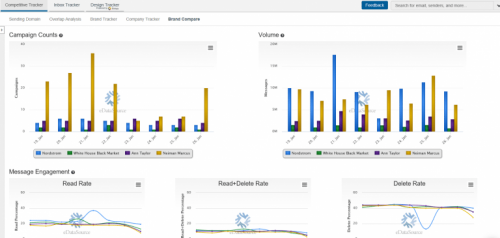What is the Right Frequency and Timing for Your Email Campaigns?
Today, many marketers have not fully optimized the frequency, cadence, and timing of their email campaigns. This includes specific questions and topics such as:
• Are you mailing too often and potentially alienating your recipients or increasing unsubscribe rates?
• Are you not sending enough and missing out on valuable opportunities to engage with your audience?
• What is the right balance to maximize open rates, click-throughs, and ultimately, revenue?
Unfortunately, most email marketers cannot answer these questions, and worse, many don’t know where to turn for the answers. Obviously, there’s a lot at stake – and a lot to be gained by getting it right.
The Competitive Tracker Advantage
Yet there is a solution: competitive intelligence applications. For example, with eDataSource’s Competitive Tracker tool, you can easily look at essential sender metrics from any competitor. This includes their total number of campaigns, emails-sent-per day, most active send times, inbox-placement rates, open rates, and much more.
In fact, research has shown that improving your competitive email knowledge – by using tools that provide engagement and performance data of your competitor’s email marketing programs – can help you generate three times more revenue than if you don’t.
With access to real, live information (panel data, not seed data), you can quickly see exactly how you stack up against the competition and then devise more effective strategies to optimize your own email campaigns. By examining the frequency, cadence, and timing of your competitors’ programs, analyzing what worked best for them, and continuing to test various contact cadences, you will put yourself in the best position to significantly improve your email marketing results.
Use Competitive Data To Improve Your Own Campaigns

With Competitive Tracker, you can see and understand everything about your competitors’ email marketing efforts, so you can devise and deploy more effective campaigns.
For example, Competitive Tracker lets you see how often your competitors send emails as well as how well these emails perform. If you see a particular company sending campaigns much more frequently than you – with strong or improving customer engagement – you may want to test a more aggressive mailing cadence for your own emails, especially to your most engaged audiences. Or test lower frequencies on your least engaged audiences.
You may also want to align these campaigns with specific events such as holidays, sales promotions, or peak retail or travel seasons, especially if these themes boost results for your competitors.
Or, if your competitors are mailing on specific days of the week – insight also available in Competitive Tracker – you can analyze this information and use it to formulate a better strategy.
In this case, you may consider a test where you send emails on the same day and time as the competition, or you may choose a completely different time, based on when you see your own customers actually opening your emails.
These are just a few examples. With Competitive Tracker, you can gain complete visibility into even more information about your competitor’s marketing efforts, including:
• Total number of email campaigns, including messages sent to all subscriber segments
• Subject lines, campaign creative, promotion strategies, and more
• Mailing volumes, depth of file (targeting) frequency, segmentation, and triggered messaging schemes
• Inbox placement by campaign
• Open and delete rates
Stay tuned for future articles where we discuss additional specific tactics and strategies you can use to improve your overall email marketing results.









